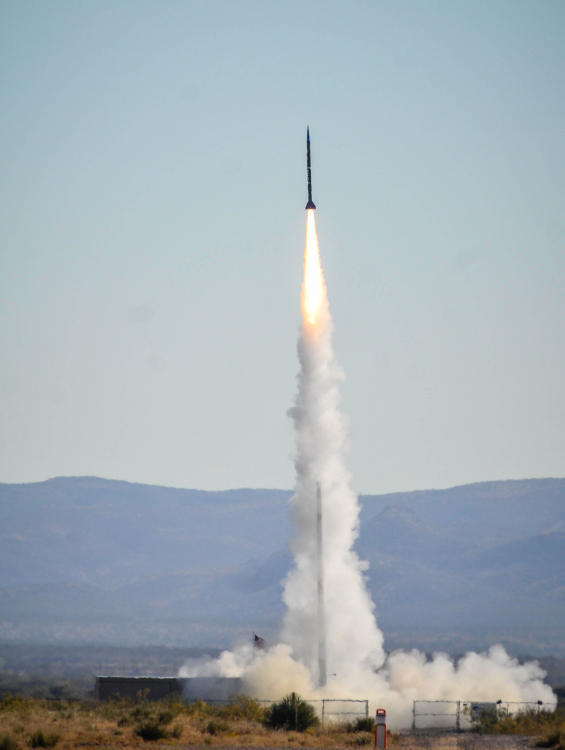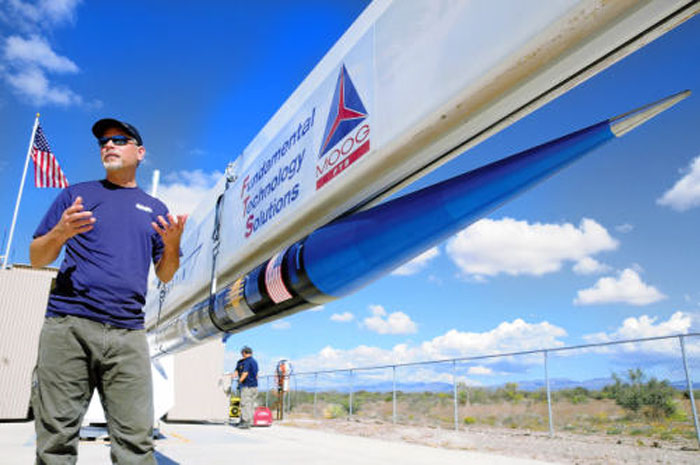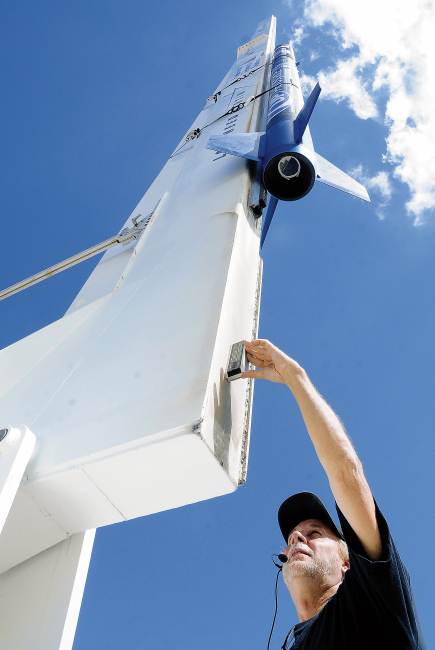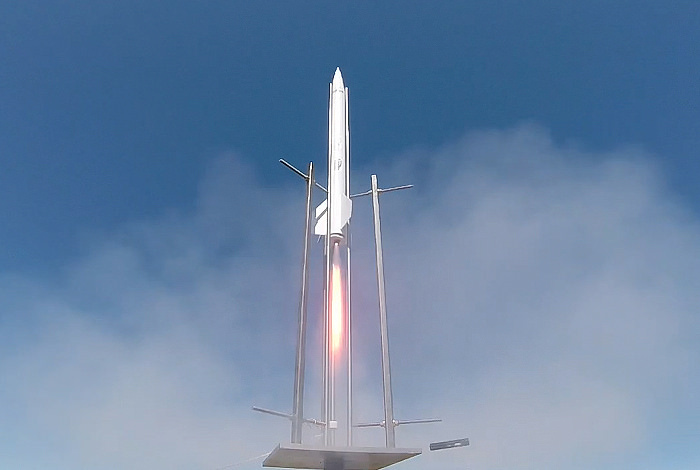.
17.10.2014

The Up Aerospace SpaceLoft 8 rocket launches at the vertical launch site of Spaceport America on a suborbital mission on November 12, 2013.
.
LAS CRUCES — UP Aerospace is set for its next suborbital launch on Monday out of Spaceport America in southern New Mexico.
It will be UP’s first flight since last year, when it launched two rockets in summer and fall with more than a dozen payloads paid for by NASA under the agency’s Flight Opportunities Program. That initiative, launched in 2011, pays commercial aerospace companies for suborbital flights to test new technologies in space.
Monday’s flight will include four payloads that UP is now packaging and loading onto its rocket, company President and CEO Jerry Larson said Thursday.
“This is our third mission for NASA,” Larson said. “All the payloads are here. We’ve been putting the vehicle together at the spaceport this week in final preparation for Monday’s flight.”
This is UP’s 13th launch from the spaceport since 2006, and the 21st time a rocket has flown from the facility since it began hosting vertical launch activities eight years ago, said Spaceport America Executive Director Christine Anderson.
“UP is a key player in NASA’s Flight Opportunities Program,” Anderson told the Journal during the International Symposium for Personal and Commercial Spaceflight, an annual, two-day event that the New Mexico Space Grant Consortium is hosting in Las Cruces this week. “We’re thrilled to have them flying here.”
UP is one of seven companies chosen in 2011 by NASA to fly payloads for the agency, and it’s one of only four companies the agency selected to continue managing flights in a new round of selections NASA announced in September.
That reflects the success of UP flights and their contributions to NASA’s space research and development efforts, said Paul De Leon, NASA’s Flight Opportunities manager for suborbital launches.
In fact, at least one of the payloads that UP flew last year — and that will fly a second time on Monday — will soon be headed to the International Space Station. It’s a device built by the engineering firm Control Dynamics Inc. that can isolate experiments from vibrations and other interference on rocket flights. That can help further lower microgravity levels for some experiments in space.
“Even though the Space Station is in orbit, some vibrations still happen that can impact experiments there,” De Leon said. “This device will reduce that.”
In general, NASA says the Flight Opportunities Program, which it launched as part of a shift to using private companies to continue space exploration after the space shuttle stopped flying, has successfully provided the agency with low-cost launch alternatives that allow it to mature new technologies.
Apart from the vibration-isolation device, for example, a 3D printer will also soon be placed on the Space Station after it is tested in a high-altitude balloon by Near Space Corp. of Oregon.
“The program is an effective means to an end for us to develop technologies for further missions in space,” Laguduva Kubendran, NASA Flight Opportunities Program executive, said Thursday in a presentation at the symposium. “We have some 140 payloads now in the pipeline to fly on commercial launches. We want to get to where we’re flying payloads through commercial companies at least every quarter, and eventually get to monthly and even weekly flights.”
UP was chosen to continue in the program given the company’s reliability, De Leon said.
“The relation with UP is very good,” he said. “They’re very detail-oriented, very reliable and all their flights have been a success.”
The contract extension announced in September could mean a lot more launches by UP out of Spaceport America. Under the initial NASA contract from 2011, UP was eligible to fly up to eight rockets with NASA payloads. The new contract extends that for another five years, with potentially more than a dozen launches.
“Under the new contract, we could earn up to $10 million,” Larson said. “This award is a lot more open-ended than the last one. We could fly as many as 15 missions.”
After Monday’s launch, two more UP flights are scheduled for next year, including one in summer and another in fall.
“We plan to stay at Spaceport America for all our launches,” Larson said. “Our operations here are working well. We want to continue flying from here for many years to come.”
Quelle: Albuquerque Journal
.
Update: 23.10.2014
.
Delayed launch from Spaceport America set for Thursday
Technology: UP Aerospace preps for 13th launch from Spaceport America

Jerry Larson, UP Aerospace launch conductor, stands next to a SpaceLoft XL rocket that will be launched today at Spaceport America. The rocket's payload will consist of experiments from a private company, Montana State University, Barcelona Technical University and NASA.
.
SPACEPORT AMERICA >> Despite a setback earlier this week because of weather, a 20-foot-long UP Aerospace rocket is prepped and ready for an early morning launch Thursday from Spaceport America.
The launch, carrying cremated human remains and some scientific experiments, will be the Denver-based company's 13th from the state-owned spaceport.
Storms on Sunday evening prompted the flight to be rescheduled from a Monday liftoff plan. But weather forecasts Wednesday left company officials optimistic it would happen Thursday instead. Wind conditions still could affect the schedule.
Typically, weather is good for launches from Spaceport America, officials said.
"This is the first time we've ever had to reset the launch day because of weather," said Jerry Larson, president of UP Aerospace and launch conductor for the mission.
The window of opportunity for the launch is between 7 a.m. and 8:15 a.m., company officials said.
The launch, UP Aerospace's third as part of a contract through NASA's Flight Opportunities Program, will carry four experiments to an altitude of about 75 miles, reaching suborbital space. Also, cremains of about 30 people will be carried on board as part of a memorial arranged by the company Celestis Inc.
Yet another payload is a batch of yeast being carried for Ninkasi Brewing Co. of Portland, Oregon.
After the rocket returns to earth, the brewery will use it to make "space beer," Larson said.
The flight is expected to last 15 minutes. The rocket, after experiencing about three or four minutes of microgravity, will float back to earth with a parachute. It will land on White Sands Missile Range, to the east of the spaceport, and will be ferried back to the launch site via helicopter, where payloads will be opened and flight data examined.


The experiments on board are meant to test developing technologies that could be used in other spaceflights activities, said Paul De León, aerospace systems engineer with NASA. The projects need to be exposed to microgravity conditions, he said.
"It's technology that needs to mature in order to be ready for missions like orbital missions or missions into deep space," said De León, who will attend the launch.
Wednesday, UP Aerospace prepped the 800-pound rocket, called a SpaceLoft XL, for the launch and ran through mission procedures. A handful of people from the company, NASA and Spaceport America will oversee the flight from the launch control center, a small trailer about a mile away from the launch pad.
The NASA program funding the flight is part of a shift by the agency toward relying on private companies to host launches, Larson said. The program also opens up access for universities to have access to spaceflights, something that hasn't been economically feasible for most institutions until now, he said.
"There are a lot of new ideas and clever ideas that come out of young minds at universities," Larson said. "That is really exciting."
The four experiments were designed by Montana State University, Barcelona Tech in Spain, NASA and a private company, according to UP Aerospace. New Mexico State University has had payloads on previous launches.
One of today's experiments will look at how bubbles move in space, De León said, which has implications for fluid systems operating in space.
UP Aerospace launched its first SpaceLoft mission at Spaceport America in 2006.
It will be the sixth UP Aerospace launch carrying cremains for Celestis, according to a news release from that company. Some family members of the people whose remains will be flown are going to watch the flight from the spaceport site or via a webcast.
"The experience of viewing a launch from Spaceport America is an unforgettable memory for the friends and family of all memorial spaceflight participants," said Celestis CEO Charles Chafer in the release.
Larson said his company was recently awarded another five-year contract from NASA to continue its work. More launches are planned from the spaceport in 2015, he said. Factors such as the facility's remoteness, nearby restricted airspace because of WSMR, reasonable launch fees and an "appropriate amount of red tape" all help to make the spaceport attractive as a location, he said.
De León said Spaceport America is the "right environment for these types of flights."
"We had a delay, but everything is looking really good for (Thursday)," he said. "We are pretty confident we'll have a great launch."
Spaceport America is a roughly $219 million taxpayer-built facility located just north of Doña Ana County.

Jim Hoffman, UP Aerospace launch pad supervisor, takes measurements Wednesday at Spaceport America. The SpaceLoft XL rocket, measuring 20 feet tall weighing about 800 pounds, will travel about 75 miles high.
Quelle: The Las Cruces Sun-News
.
Update: 26.10.2014
.
In One Place (Buzzwok)Scientists recently flight tested a new rocket design that includes a high-energy fuel and a motor design that also delivers a high degree of safety.

Rocket flight test at the Energetic Materials Research and Testing Center launch sitE near Socorro, NM.
.
New rocket propellant and motor design offers high performance and safety
LOS ALAMOS, N.M., Oct. 23, 2014—Los Alamos National Laboratory scientists recently flight tested a new rocket design that includes a high-energy fuel and a motor design that also delivers a high degree of safety.
"What we're trying to do is break the performance versus sensitivity curve, and make a rocket that's both very high-energy, as well as very safe," said Bryce Tappan, an energetic materials chemist at the Laboratory. "Typically, when you look at a propellant that's high-performance, it's not as safe a material."
See the flight tests and hear how Tappan and his research partners at New Mexico Tech and Penn State accomplished a fully successful flight in a new video on the Laboratory's YouTube Channel.
Los Alamos novel rocket design flight tested
2:52
.
Conventional solid-fuel rocket motors work by combining a fuel and an oxidizer, a material usually rich in oxygen, to enhance the burning of the fuel. In higher-energy fuels this mixture can be somewhat unstable, and can contain sensitive high explosives that can detonate under high shock loads, high temperatures, or other conditions.
The new rocket fuel and motor design adds a higher degree of safety by separating the fuel from the oxidizer, both novel formulations that are, by themselves, not able to detonate.
"Because the fuel is physically separated from the oxidizer," said Tappan, "you can utilize higher-energy propellants."
After years of development and bench-top static tests, the new rocket design was recently flight tested at the Energetic Materials Research and Testing Center's Socorro launch site, part of New Mexico Tech. The new rocket design was tested against conventional, high-energy commercial rockets to enable a comparison of data gathered on velocity, altitude, burn rate, and other parameters.
"You don't have to do much more than a few seconds of YouTube searching to find numerous failed rocket tests," said Tappan. "So, I had that worry in the back of my mind. But once we saw that successful launch go off, it was the culmination of a lot of years of research, it was very satisfying to see it fly."
Researchers will now work to scale-up the design, as well as explore miniaturization of the system, in order to exploit all potential applications that would require high-energy, high-velocity, and correspondingly high safety margins.
Quelle:Los Alamos National Laboratory
5187 Views
